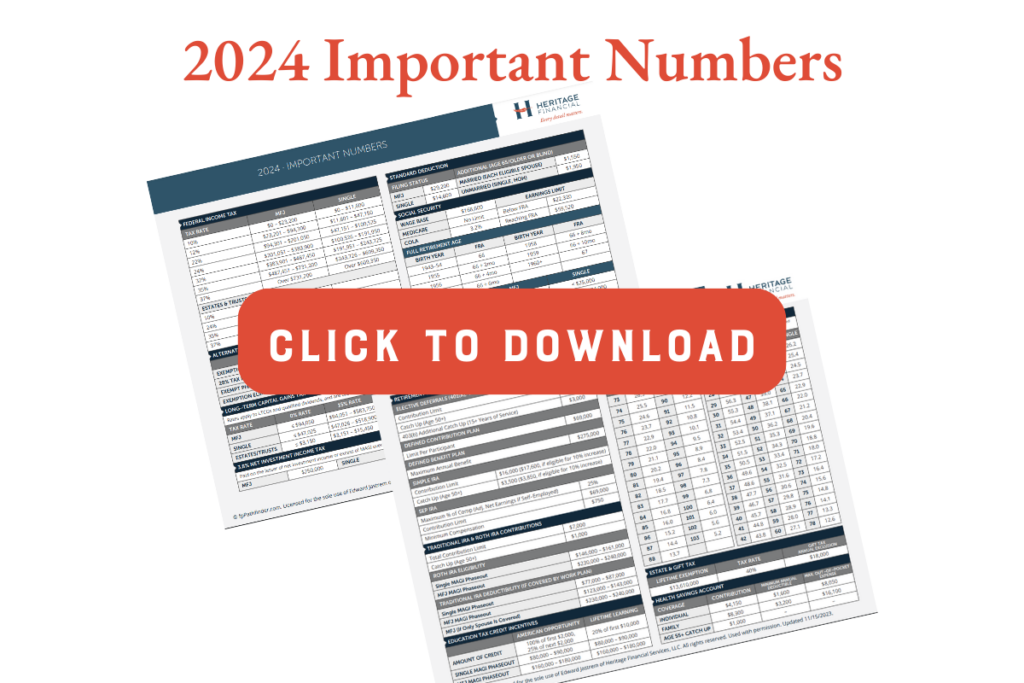1. Maximize Retirement Plan Contributions
There’s still time to max out contributions to 401(k), 403(b) or other tax-deferred plans to boost your long-term retirement savings. The 2024 limit on employee elective contributions to 401(k), 403(b) and 457 plans is $23,000. If you are age 50 or older this year, you can make an additional catch-up contribution to most plans of $7,500 to reach $30,500 total. If you changed jobs during the year, make sure you coordinate the total contributions to not over or under contribute. View “2024 Important Numbers” for a summary of 2024 contribution limits.
2. Take Advantage of Group Benefits
Many employees have an open-enrollment period for group benefits at year-end. While the focus tends to be on health insurance options, other benefits such as disability insurance, life insurance, and discount or wellness programs shouldn’t be overlooked. Higher earners should pay particular attention to available pre-tax benefit plans such as Flexible Spending Accounts for dependent care and/or healthcare as well as Health Savings Accounts (HSA).
3. Use It or Lose It
Health Savings Accounts can be invested for growth and used in retirement like a “medical IRA” for future healthcare expenses. But Flexible Spending Accounts are “use it or lose it.” If you use your employer’s Flexible Spending Account, you may need to use up any remaining balance by year-end or risk losing what you saved. Some employers extend a grace period for submitting expenses. Others may allow you to rollover some of your account balance. Know the rules that apply to your plan, so you don’t lose what you saved.
4. Take Advantage of a Lower Income Year
If you find yourself in a lower tax bracket for 2024, consider taking advantage of strategies to benefit from your circumstances. There may be an opportunity to realize some long-term capital gains with zero tax liability. Converting an IRA to a Roth IRA or withdrawing earnings from a tax-deferred account may also be effective ways to manage income taxes if you expect to be in a higher bracket in the future. If you pay taxes on a Roth conversion now, future withdrawals can be income tax-free.
5. Consider Gifts to Individuals
In 2024, you can gift up to $18,000 a year to as many people as you choose ($36,000 if you and your spouse both make the gift) without any gift tax consequences. You can also make payments of tuition or medical expenses on behalf of another person if the payment is made directly to the billing institution. Taking advantage of gifting opportunities can reduce the size of your taxable estate, leading to lower federal or state estate taxes in the future. View “2024 Important Numbers” for a summary of 2024 limits.
6. Help Fund an Education
529 Savings Plans offer a tax-favored way to invest in education. If you are funding 529 savings plans for children, grandchildren or others, those contributions count as gifts toward your $18,000 or joint $36,000 annual exclusion per recipient. There is also a special strategy called “superfunding” that allows up to 5 times the annual gift exclusion for contributions into 529 plans without using any of your lifetime gift or estate tax exclusion. Wondering how this works? Ask us here.
7. Think Twice Before Sending Cash
Sometimes there are more tax-efficient ways to give to charity than cash. Giving gifts of appreciated stock, using a Donor Advised Fund, or making a Qualified Charitable Distribution from an IRA are all strategies that allow you to share your wealth while benefitting from tax-savings at the same time. Completing charitable gifts before calendar year-end may require paperwork and communication with your tax advisor. If you have questions, we can help.
8. Check Your Available Liquidity
Before year-end bills come due or you prepare to make an estimated tax payment in January, evaluate your upcoming cash needs relative to your current cash balance. If you need to sell investments or withdraw from an IRA to cover expenses, you may want to determine for tax purposes if it is best to make the transaction this year, next year, or split over both. If you only need funding to bridge a short timing window, it’s possible that borrowing could be a more cost-effective solution than a taxable portfolio withdrawal. While you’re at it, check the interest rate on your bank savings and make sure it is competitive.
And finally, our last tip won’t necessarily maximize your wealth, but it will help keep business owners in compliance with Federal regulations.
9. Submit Beneficial Ownership Information for LLCs and Small Businesses
The Corporate Transparency Act created a new compliance requirement for many corporations and LLCs . This applies even to LLCs that are not operating businesses like those which may only exist for estate or liability planning. Reporting entities will need to submit data about underlying owners to the Financial Crimes Enforcement Network. Companies created before January 1, 2024, have until January 1, 2025, to submit information online. Companies created during 2024 have 90 days to submit beneficial owner information.
UPDATE December 9, 2024: In light of a recent federal court order, reporting companies are not currently required to file beneficial ownership information with FinCEN and are not subject to liability if they fail to do so while the order remains in force. However, reporting companies may continue to voluntarily submit beneficial ownership information reports. Read more here.
There are many strategies for serious investors to maximize their wealth. Don’t worry. You don’t need to be an expert. You just need to have an expert on your team.
If you are a client of Heritage Financial, we’ve got you covered. We will be reviewing these with you as the year comes to a close. Please make sure to update us on any changes to your professional relationships (accountants, estate attorneys, insurance professionals) and share your most recent tax returns with us.
If you aren’t a client of Heritage Financial yet but wondering how you might maximize your wealth by using some of these strategies, let’s talk.




